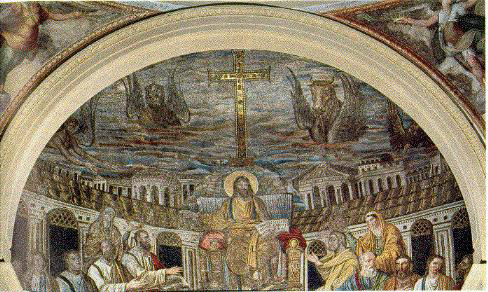Re: Re: reordering and destruction of irish cathedrals – St Colmans Cathedral, Cobh
Home › Forums › Ireland › reorganisation and destruction of irish catholic churches › Re: Re: reordering and destruction of irish cathedrals – St Colmans Cathedral, Cobh

To return to the subject of the mosaic of Santa Pudenziana with its depiction of Christ seated in glory, surrounded by the tetramorphai, we pointed out in posting # 342 the various elements of the mosaic borrowed from pagan Greek and Roman art to depict Christ in such a way as to attribute divinity to him. Seeing these, the average Roman or indeed Greek pagan of the year 390 would automatically assume from the figure of Christ in the ,mosaic that he was a divine person – since his depiction repeats all of the usual elements of Roman and Greek art to underline the quality of divinity (the halo, the beard, the long loose hair, his session on a type throne reserved to Jupiter). The question is: why the emphasis on Christ’s divinity and the insistence on it? The answer probably lies in the theological culture of the time which was heavily dominated by the Arian heresy, specifically denying the divinity of Chirst, which was condemned at the Council of Nicea in 325. Clearly, the Basilica of Santa Pudenziana in 390 was in the hands of orthodox Catholic worship which may explain the rather pointed script on book held by the Christ figure:Dominus Conservator Ecclesiae Pudentianae (The Lord is the protector of Pudentiana’s Church). The broad outline of the controversy can be seen by following this link:
http://www.newadvent.org/cathen/01707c.htm
However, while pagan artistic prototypes were used to create a depiction of Christ that would assert his divinity, the scene which is being depicted is taken directly from the last book of the Bible, the Revelation (or Apocalypse) of St. John chapter 4: 1-11. The Text reads:
” 1After this I looked, and behold, a door standing open in heaven! And the first voice, which I had heard speaking to me like a trumpet, said, “Come up here, and I will show you what must take place after this.” 2At once I was in the Spirit, and behold, a throne stood in heaven, with one seated on the throne. 3And he who sat there had the appearance of jasper and carnelian, and around the throne was a rainbow that had the appearance of an emerald. 4Around the throne were twenty-four thrones, and seated on the thrones were twenty-four elders, clothed in white garments, with golden crowns on their heads. 5From the throne came flashes of lightning, and rumblings[a] and peals of thunder, and before the throne were burning seven torches of fire, which are the seven spirits of God, 6and before the throne there was as it were a sea of glass, like crystal.
And around the throne, on each side of the throne, are four living creatures, full of eyes in front and behind: 7the first living creature like a lion, the second living creature like an ox, the third living creature with the face of a man, and the fourth living creature like an eagle in flight. 8And the four living creatures, each of them with six wings, are full of eyes all around and within, and day and night they never cease to say,
“Holy, holy, holy, is the Lord God Almighty,
who was and is and is to come!”
9And whenever the living creatures give glory and honor and thanks to him who is seated on the throne, who lives forever and ever, 10the twenty-four elders fall down before him who is seated on the throne and worship him who lives forever and ever. They cast their crowns before the throne, saying,
11′ Worthy are you, our Lord and God,
to receive glory and honor and power,
for you created all things,
and by your will they existed and were created’ “.
The text of Revelations is not an isolated text in Biblical literature and must be situated in the tradition of the Jewish apocalyptic liteature of the Old Testament on which it draws heavily. In the case of the heavenly court the borrowing comes specifically from the Prophet Ezekiel chapters 1 and 10 (http://www.biblegateway.com/passage/?book_id=33&chapter=1&version=47 and http://www.biblegateway.com/passage/?book_id=33&chapter=10&version=47) where we find the the four beasts, the ealders and the Deity seated on the throne.
The novum of Revelations, however, is that Christ is placed on the heavenly throne thereby asserting, in Jewish terms, that he is God, thereby making the basic profession of Christian faith, namely, that Jesus is Lord.
The beasts described by Ezekiel reappear in Revelations and surround the throne. At this point, they are not associated, at least explicitly, with the four Evangelists. That association would first be made by Irenaeus of Lyons (died 202) in his Adversus Haereses, Book III, chapter 3, paragraph 8 (http://www.ccel.org/fathers2/ANF-01/anf01-60.htm#P7409_1981656) written c.175-185 A.D.. This text gives us the historical terminus a quo for the artistic tradition of the depiction of Christ to be found in the tympanum of the West door in Cobh Cathedral. It supplies the original historico-cultural context for that depiction, which is the Arian heresy and the measures taken to counter it. It also supplies us with the interpretative key for reading and understanding both the theological and artistic concerns lying behind the artistic type: Christ’s divinity.
